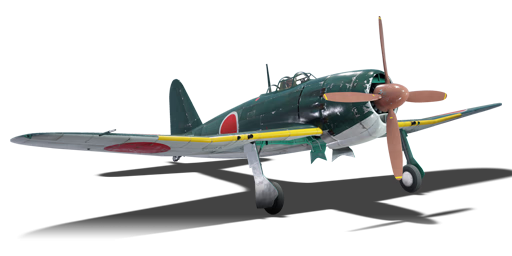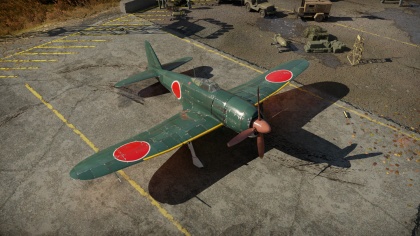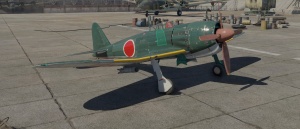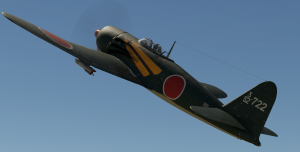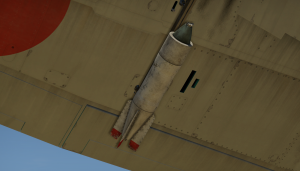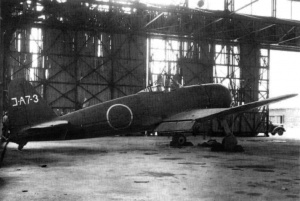A7M2
Contents
| This page is about the Japanese fighter A7M2. For premium version, see A7M1 (NK9H). |
Description
The A7M2 Reppu is a rank IV Japanese fighter
with a battle rating of 5.0 (AB), 5.3 (RB), and 4.7 (SB). It was introduced in Update 1.55 "Royal Armour".
General info
Flight performance
The A7M Reppu was designed to be an improved version of the famed A6M Zero fighter, and as such, retains some of its legendary older brother's characteristics. The Reppu is an overall smooth operator at most altitudes thanks to its decent acceleration, vastly improved speed and decent manoeuvrability. Less manoeverable than the Zero, it can at certain times really struggle in dogfights, the rudder has a want to fight you at every turn requiring forceful control and slight damage to the airframe negates most of its ability to dogfight anything but the slowest turners effectively. The most noteworthy change is the replacement of the underpowered Nakajima Sakae Radial engine with a significantly more powerful Mitsubishi Ha-43 Radial. This new engine propels the Reppu to higher speeds previously unobtainable by the Zero and turns this aircraft from a nuisance to a universally feared opponent.
| Characteristics | Max Speed (km/h at 5,660 m) |
Max altitude (metres) |
Turn time (seconds) |
Rate of climb (metres/second) |
Take-off run (metres) | |||
|---|---|---|---|---|---|---|---|---|
| AB | RB | AB | RB | AB | RB | |||
| Stock | 608 | 589 | 11000 | 19.3 | 20.2 | 15.1 | 15.1 | 250 |
| Upgraded | 654 | 630 | 18.8 | 19.0 | 22.8 | 18.5 | ||
Details
| Features | ||||
|---|---|---|---|---|
| Combat flaps | Take-off flaps | Landing flaps | Air brakes | Arrestor gear |
| ✓ | ✓ | ✓ | X | ✓ |
| Limits | ||||||
|---|---|---|---|---|---|---|
| Wings (km/h) | Gear (km/h) | Flaps (km/h) | Max Static G | |||
| Combat | Take-off | Landing | + | - | ||
| 826 | 310 | 510 | 510 | 280 | ~12 | ~9 |
| Optimal velocities (km/h) | |||
|---|---|---|---|
| Ailerons | Rudder | Elevators | Radiator |
| < 400 | < 380 | < 400 | > 324 |
Survivability and armour
- 70 mm bulletproof glass in front of the pilot
- 13 mm steel plate behind the pilot seat
- Self-sealing fuel tanks
While being slightly more durable than its older brother, the Reppu is still very vulnerable to any kind of battle damage. Anything with greater than .50 calibre weapons will be able to take off a wing or worse. The wingspan has also increased significantly to keep the manoeuvrability of the Zero while supporting increased weight added from the guns, engine and other updates. A downside is that this makes the wings easier to hit. However, The manoeuvrability of the Reppu allows this aircraft to avoid most damage if you can keep turning.
Armaments
Offensive armament
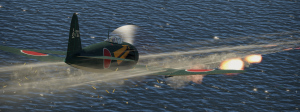
The A7M2 is armed with:
- 2 x 20 mm Type 99 Model 2 cannons, wing-mounted (200 rpg = 400 total)
- 2 x 13.2 mm Type 3 machine guns, wing-mounted (300 rpg = 600 total)
Suspended armament
The A7M2 can be outfitted with the following ordnance:
- Without load
- 2 x 60 kg Navy Type 97 Number 6 bombs (120 kg total)
- 2 x Type 3 No.1 Mod.28 Mk.1 rockets
- 2 x Type 5 No.1 Mod.9 rockets
- 2 x Type 3 No.6 Mod.27 Mk.1 rockets
- 2 x Type 5 No.6 Mod.9 rockets
Usage in battles
The A7M is played almost exactly like the Zero, but with a few changes due to the good performance. Due to its high top speed (for an IJN plane at least) and good dive speed, it can tailor to any form of dogfighting. It can turn fight in the right situation, energy fight, Boom-&-Zoom and others.
It is mandatory to keep your energy up at all times, as you can suitably engage opponents in multiple ways by doing so. Keep your speed at a medium and maintain altitude. A low flying Reppu is an easy prey for diving Americans and Russians that dive on you. However, you can attempt to pull rolling manoeuvres to avoid their strafe or turn as soon as they get within range.
Manual Engine Control
| MEC elements | ||||||
|---|---|---|---|---|---|---|
| Mixer | Pitch | Radiator | Supercharger | Turbocharger | ||
| Oil | Water | Type | ||||
| Controllable | Controllable Not auto controlled |
Controllable Not auto controlled |
Controllable Not auto controlled |
Separate | Controllable 2 gears |
Not controllable |
Modules
| Tier | Flight performance | Survivability | Weaponry | |||
|---|---|---|---|---|---|---|
| I | Fuselage repair | Radiator | Offensive 13 mm | Type 3 No.1 Mod.28 Mk.1 rockets | ||
| II | Compressor | Airframe | New 13 mm MGs | Type 5 No.1 Mod.9 rockets | 9 in (mod30) | |
| III | Wings repair | Engine | Offensive 20 mm | Type 3 No.6 Mod.27 Mk.1 rockets | ||
| IV | Engine injection | Cover | New 20 mm cannons | Type 5 No.6 Mod.9 rockets | ||
Pros and cons
Pros:
- Performance; comparable/better than the A6Ms:
- Surprisingly agile at all altitudes and most speeds
- Vastly improved speed and diving ability
- Can dogfight situationally
- Armament:
- Large ammunition pool
- Fields 13.2 mm machine guns unlike most other Japanese fighters using 7.7 mms
- Can mount unguided rockets
- Larger rockets are useful on ground targets
- All can be set with a fuse to be used as air-to-air
- Other:
- 70 mm bulletproof glass in front of the pilot
Cons:
- Significantly increased size compared to A6M
- Flimsy and large wings, easily damaged
- Roll rate extremely slow, slow turn prep
- Control stiffening begins at relatively low speeds
- 13.2 mms jam faster than other 12.7 mm counterparts.
History
As the A7M1 was a letdown for the navy, which made them want to cancel the project still allowed Mitsubishi to develop into making an A7M with an in-house engine, being the Mitsubishi Ha-43 which had more power and would be the engine to succeed to the Navy's requirements.
As so, the new A7M2 with Ha-43 had its test flight in October 1944 by no-one other than Saburo Sakai and proved more than capable with checking off most requirements by some slight underperformance of speed. As the aging A6M doesn't compare to the A7M2, the Navy cancelled the formal cancelation of the A7M project and adopted the A7M2 as their new main carrier-based fighter.
In late 1944 an earthquake strained the manufacturing of the A7M2 causing only 8 to be built. In early 1945, Allied bombings of Japans mainland lead to the destruction of the A7M plans. This ceased the whole development of the A7M2 and the plane would never see combat.
Only a single A7M2 would be built in 1945 due to allied bombings and none remain surviving WWII.
Media
- Skins
- Videos
See also
Links to the articles on the War Thunder Wiki that you think will be useful for the reader, for example:
- reference to the series of the aircraft;
- links to approximate analogues of other nations and research trees.
External links
Paste links to sources and external resources, such as:
- topic on the official game forum;
- encyclopedia page on the aircraft;
- other literature.
| Mitsubishi Company (三菱商会) | |
|---|---|
| Fighters | A5M4 · Hagiri's A5M4 |
| A6M2 mod. 11 · A6M2 · A6M3 · A6M3 mod. 22 · A6M3 mod. 22Ko · A6M5 · A6M5 Ko · A6M5 otsu · A6M5 Hei · A6M6c | |
| A7M1 (NK9H) · A7M2 | |
| J2M2 · J2M3 · J2M4 Kai · J2M5 · J2M5 (30 mm) | |
| Hydroplanes | F1M2 |
| Interceptors | Ki-83 · Ki-109 |
| Bombers | G4M1 |
| Ki-21-Ia · Ki-21-I hei · Ki-67-I Ko · Ki-67-I otsu | |
| Jet Fighters | Ki-200 |
| Captured | ▃A6M2 · ␗A6M2 |
| See also | Mitsubishi Heavy Industries, Ltd. (Post-War) |
| Japan fighters | |
|---|---|
| Navy | |
| Carrier-based fighter | |
| A5M | A5M4 · Hagiri's A5M4 |
| A6M | A6M2 mod. 11 · A6M2 · A6M3 · A6M3 mod. 22 · A6M3 mod. 22Ko · A6M5 · A6M5 Ko · A6M5 otsu · A6M5 Hei · A6M6c |
| A7He | A7He1* |
| A7M | A7M1 (NK9H) · A7M2 |
| Land-based Fighter | |
| J2M | J2M2 · J2M3 · J2M4 Kai · J2M5 · J2M5 (30 mm) |
| J6K | J6K1 |
| J7W | J7W1 |
| N1K-J | N1K1-Ja · N1K2-J · N1K2-Ja |
| Fighter seaplane | |
| N1K | N1K1 |
| A6M-N | A6M2-N |
| Army | |
| Ki-10 | Ki-10-I · Ki-10-I C · Ki-10-II · Ki-10-II C |
| Ki-27 | Ki-27 otsu · Ki-27 otsu Tachiarai |
| Ki-43 | Ki-43-I · Ki-43-II · Ki-43-III otsu |
| Ki-44 | Ki-44-I · Ki-44-I 34 · Ki-44-II otsu · Ki-44-II hei |
| Ki-61 | Ki-61-I ko · Ki-61-I otsu · Ki-61-I hei · Tada's Ki-61-I hei · Ki-61-I tei · Ki-61-II Otsu Kai |
| Ki-84 | Ki-84 ko · Ki-84 otsu · Ki-84 hei |
| Ki-87 | Ki-87 |
| Ki-94 | Ki-94-II |
| Ki-100 | Ki-100 · Ki-100-II |
| Other countries | ▅F4U-1A · ▅P-51C-11-NT · ▅Bf 109 E-7 · ▅Fw 190 A-5 |
| *Imported designation of the He 112 (A6M was in development - A7M would take A7 designation after the cancelation of the A7He) | |


